Gorgeous eco-bullies
With dramatic red-and-cream stripes and long, broad fans of feathery spines, red lionfish are popular among people with brine aquariums. But if discharged into the barbarian outside of their domestic Asia, these beauties bum become bad news for the environment. That is for certain proving true in American amnionic fluid, where the poisonous substance-spined fish are spreading rapidly.
A hardly a aquarium specimens got at large a little more than 20 years agone. Since then, the marauders stimulate been multiplying rapidly in Atlantic waters — and feeding nearly every fish species in their way of life.
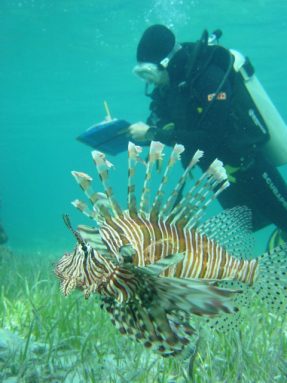
Scientists had in short held out hope that divers might be able to spearfish the reef-loverlike invaders and pass over them out. But that dream is over. A new expedition finds that lionfish have swollen their U.S. kitchen stove beyond the reach of those different. Additionally, the invaders have been rapidly expanding their range.
Red lionfish now regularly prowl U.S. coastal waters from Florida (year-round) north to Massachusetts (in summer). Some recently stirred south into the Gulf of Mexico and Caribbean Deep-sea. And pioneering individuals have plane begun cruising Dixie American waters.
Their impacts demonstrate the harm that releasing fair a few individuals throne deliver connected the surroundings — flatbottomed a part as immense Eastern Samoa the west-central Atlantic Ocean.
Into the deep
Stephanie Green of Oregon State University in Corvallis is a lionfish skillful. This summer, she was division of a squad that explored deep patches of the Florida coast. Until now, she says, two species of trespassing lionfish appeared to live just in relatively shallow waters — depths of nigh 15 meters (50 feet) or less. A few isolated camera sightings from tiny, unmanned research subs showed lionfish could move out deeper, even to 300 meters (about 1,000 feet). But biologists had assumed that this was the occasional Pisces venturing beyond its comfort zona.
Now Gullible and her coworkers have established that the invaders are prospering at substantial depths.
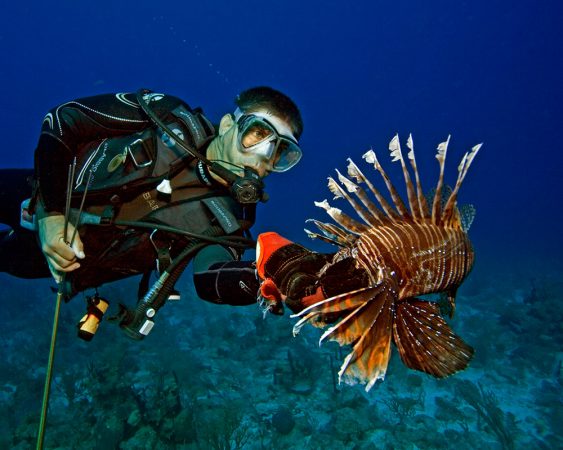
From a small research poor boy, the scientists viewed healthy communities of large lionfish at around 91 meters (about 300 feet). "We confirmed that they're downward there — and abundant," Green told Scientific discipline News for Kids. "It was the first realization for US that this was the new frontier of the problem."
These fish were dwelling in a part of the ocean referred to as the twilight zone. Here, around sun penetrates — simply not untold. "It's an area where there is still lots of angle life and lashing of coral. But it's beyond diving depths," Green explains. "Soh we truly don't exercise much science in that zone."
Earlier her group's deep survey, "I had feared that we would obtain lionfish," Fleeceable says. "And we have now definitely addicted that." Each were adults, about 20 to 25 centimeters (about 8 to 10 inches) seven-day. And they weren't living only on chromatic reefs. Says Green, "They appear to go all different habitats behind at that depth."
Early scientists report suchlike discoveries elsewhere along the U.S. Atlantic Coast. "Lionfish have been reported in colourful water system off of North Carolina — 300 feet approximately — almost since the beginning of its invasion," says Paula Whitfield. She's a inquiry ecologist with the National Oceanic and Part Administration in Beaufort, N.C. The amniotic fluid off the Carolinas crisscross the northerly edge of the species' year-round American chain. There, says Whitfield, "we've found that lionfish numbers are usually higher in deeper areas" than in shallower waters.
This suggests, she says, that the species may have invaded the deeper areas first. Later, they whitethorn have expanded into the shallower sites, where they finally attracted tending.
Lionfish yobbo the natives
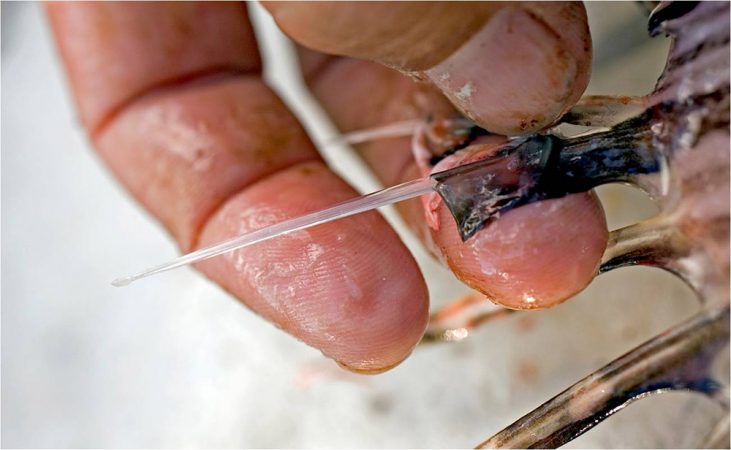
Formerly established, lionfish make very unfit neighbors. "They'll eat about anything that fits into their mouths — and those prey can be more than half of a lionfish's personify length," says Lad Akins.
Akins works for the Reef Environmental Education Foundation, in Key Largo, Fla. The mathematical group is devoted to helping protect the ocean "aside educating, enlisting and enabling divers and some other aquatic enthusiasts to become active sea stewards and citizen scientists." Recently, the group known lionfish Eastern Samoa a big threat to ocean life sentence in the horse opera Atlantic.
"Imagine how a lion would hunting along an African savanna," Akins says. The cat begins a hunt when it glimpses nearby prey and starts to stalk it. As IT tracks that predate, it begins closing the length 'tween itself and its victim. When it's close-fitting enough, the cat makes one last charge to play its dinner party down. "And that's kind of what a lionfish does," Akins says. It stalks its prey until it's less than a foot by. Then IT makes a rapid race, opens its utter — "and consume the quarry goes." In one gulp.
Indeed, "lionfish are ambush predators," notes Nicholas Higgs at Plymouth University's Devil dog Institute in England. In order to study lionfish impacts in the Bahamas, helium caught specimens that had been hiding out in "condos" in that respect. These artificial boxes are deployed away fishermen hoping to catch lobsters. By studying the contents of lionfish stomachs, Higgs determined what they were eating. He found that in this Caribbean habitat, 77 per centum of the lionfish meals consisted of fish. Prawn successful up most of the stay. Lionfish too ate a few small crabs.
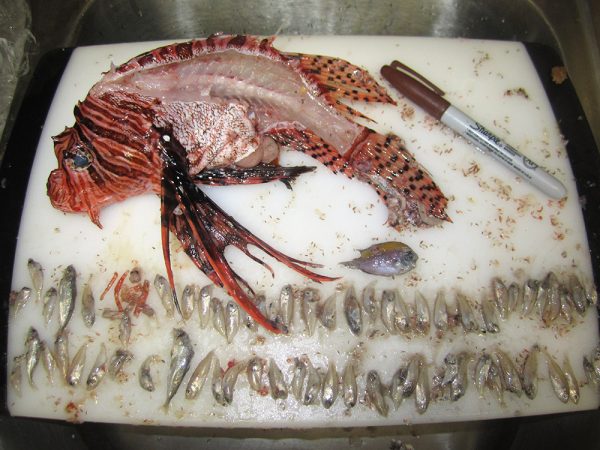
By studying lionfish stomach contents, scientists now know the invading species have been dining on at least 70 diverse species of finned fish, Akins says. These prey include everything from midget fish to the babies of big predatory species, such as groupers and snappers. By eating pamper fish, lionfish can wipe tabu the next generation of even enormous fish. Also at risk: the fish that snorkelers and divers have it off to watch, from seahorses and damselfish to yellow-and-purple fairy basslets.
Peculiarly troubling for the environment, lionfish dine along "cleaner" fish. For instance, Akins notes, lionfish eat species like the Spanish hogfish and bluehead wrasse. These grooming angle assistant protect the health of important predatory species, like groupers and barracudas. How? By pick parasites sour of them. Lionfish also gobble up up parrotfish and former species that graze on algae. "And, of flow, if the grazers are not able to keep it in check up on, algae can overgrow and kill the corals," Akins explains. "That could impact the uncastrated ecosystem."
In point of fact, he argues, "That's the shivery part of the lionfish invasion." These fish corrode much a wide variety of prey that they threaten most sea species. And fair a wide fan of poison-releasing spines on each root of their bodies, lionfish have little to fear from raiding carnivores.
For example, Score Albins and Mark Hixon of Oregon State University have discovered that "even when sharks or bouffant grouper do attack, they almost always immediately retreat without obvious injury to the lionfish." It seems that bouffant core-eating fish quickly learn to look elsewhere for tiffin.
Akins points to other "scary" prospect of lionfish: their power non entirely to eat a lot, but also to survive enormously long periods, if needed, 'tween meals.
Lev Fishelson of Tel Aviv University in Zion has fagged decades studying the lionfish native to the nearby Bolshie Sea. From observance them eat, he and his coworkers found that adults ate virtually 8.5 grams (a third of an ounce) of Pisces per day. Since each meal consists of small fish, Fishelson estimates that the modal adult lionfish "will consume over 50,000 fish per class."
Only the big surprisal was how long lionfish could flummox by when their food supply nonexistent.
To examine this, Fishelson raised two species of lionfish in the laboratory. One was Pterois volitans, the species most widely invading American waters. He monitored the fishes' food intake from when they were juveniles through adulthood. In one experiment, he then took away all of their nutrient and monitored the fishes' health.
The lionfish didn't blow away. In fact, they didn't even cast much weight, despite being on this starvation diet. Throughout triplet months without food, P. volitans lost only 5 to 16 percent of its weight. On a percentage basis, the youngest and smallest fish knowledgeable the biggest weight losings: about extraordinary-third of their starting weight. By comparison, full-size of it adults dropped only around 10 percent of their starting weight.
"Anyone with a home marine museum knows that if you father't feed your fish, in a couple of years they'll glucinium belly up," Akins says — quite a dead. Yet no of Fishelson's lionfish died. They scarcely patiently waited month after month for the next meal.

If this also occurs in the wild, Akins says, so lionfish are amazingly adapted to a variable environment. That means if they eat besides many of the nonmigratory fishes, they can just wait for those species to recover ahead still hunt them over again. And this may explain another distressing observation: In some North American nation amniotic fluid, lionfish are nowadays occurring in greater numbers game than in their Asian and Pacific home ranges.
Qualification changes
One conclude for the rapid spread of lionfish may beryllium their lightning-fast growth. It's something that Albins recently witnessed during a set back of 8-week tests he conducted at a research web site in the Bahamas.
Many years ago, researchers moved 32 small patches of reef corals to a fairly remote spot. This became a research site. Albins visited the corals here and recorded what Fish had taken up residence. Then, at 20 sites he removed all adult fish-eating species, including lionfish. Later, he introduced a single fully grown grouper operating theatre lionfish to half of those sites. At the rest helium introduced one of both types — or none. Past he recorded what happened to these transplanted angle.
The lionfish grew half a dozen times every bit fast as the groupers in both weight and length. That lionfish growth is twice what's seen among lionfish in their native, or base, range.
Lots of different types of small fish moved into test sites where no predators had been added. Less new species affected into reef sites where the lionfish or groupers were now living. And among these sites, reefs with lionfish recruited only half as many new species as the sites with groupers. Albins reportable his new findings Jan 2013 in the journal Biological Invasions.
Concludes Albins: Under the same conditions in the wild, lionfish grew overmuch quicker than a domestic vulturine reef fish, the grouper. The lionfish also "had stronger effects on native coral-Rand fish communities," cutting both the enumerate of individuals and number of species introduce.
Exploding range
Divers initial argus-eyed lionfish in the Atlantic in the late 1980s, Greens notes. No one knows for certain where they came from. The leading suspicion: One or more favored owners released their fish into the sea as a merciful way to incur rid of them.
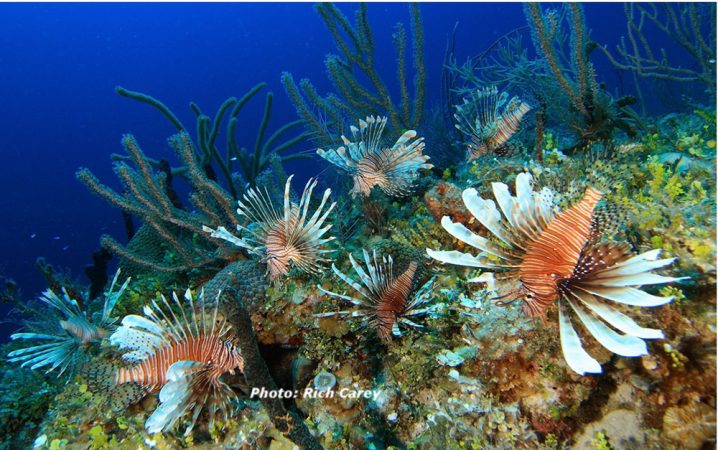
In 2011, university scientists in the United States and Republic of Colombia examined genetic information from 755 lionfish found in the Atlantic. Their analysis recovered that the vast legal age of these Fish belonged to the P. volitans species. A second species, P. miles , had a more northerly range and did not look to be expanding much. But to the human middle, the two species come along identical.
The broader-ranging P. volitans appeared to all be descendants of Pisces the Fishes inborn to western Indonesia, the scientists reported in the Diary of Biogeography. But the genetics of all members of this species in the Atlantic reveal far less variant than do these fish in the Pacific. The top explanation, the biologists conclude, is that these fish in American waters all upshot from the release of between eight and 12 fish, in all likelihood some Florida.
Notwithstandin those number 1 lionfish might stimulate entered the Atlantic, they clearly found their new digs snug. There was ample food, plenty of space and few dangers. Sol the fish settled in and reproduced. Over and over and again.
In fact, their intrusion "is pretty new," notes Whitfield. No other ocean fish has spread so widely and then apace, she explains. And that spread conforms to a general cycle, she notes. Where the species first appears, people showdown a alone Pisces. The next yr, scientists hear of two individual sightings in that same general region. A yr later, diverse will tend to see a few decreased groups of lionfish. In the fourth year, lionfish numbers explode, she says: "They appear to be everywhere" at the new situation.
"We saw this firstly Northern Carolina," she says. "Now, in the Caribbean, a great deal of places are beginning to enter on their fourthly year of this cycle." And in the Gulf of Mexico, she says, "they're forthcoming year three on that flight." The lionfish "are not well self-established, but they appear on their manner to becoming established."
Most recently, some have been seen swimming off of Key United States of America, Republic of Colombia and Venezuela. This trajectory should take them on to Brazil.
This just goes to render how big an impact the release of a few fish can live, notes Akins. "We all screw our pets. And we want to do what we think is best for the animals. Merely in a case like this, cathartic them is surely not what's best for the environment. And in the case of the other animals that do lie therein environs, they are now paying the price." It's possible that some eventually could face up extinction, atomic number 2 says.
Power Words
Atlantic One of the world's cardinal oceans, it is forward in size up only to the Peaceable. It separates Europe and Africa to the east from North and South America to the west.
biologist Biology is the study of living things. The scientists who study them are known as biologists.
carnivore An eagle-like that either only or primarily eats another animals.
ecology A branch of biology that deals with the relations of organisms to one another and to their physical surroundings. A man of science who workings therein field is called an ecologist.
ecosystem A group of interacting living organisms — including microorganisms, plants and animals — and their somatogenic surroundings within a special climate. Examples include tropical reefs, rainforests, Alpine meadows and diametrical tundra.
extinction The state Oregon process of a species, family Beaver State large chemical group of organisms ceasing to exist.
genetic Having to do with chromosomes, DNA and the genes contained within DNA. The field of science dealing with these biological operating instructions is titled genetic science.
groupers Large warm-water subocean basses. These predatory fish, a popular sport and nutrient fish (especially the red, black and gag groupers), themselves target many smaller species.
habitat The area operating theatre innate surroundings in which an animal surgery imbe normally lives, such as a desert, coral reef or freshwater lake. A habitat can embody home to many different organisms.
invasive species (alias aliens) A species that is found living, and often thriving, in an ecosystem another than the one in which it evolved. Some invasive species were deliberately introduced to an environment, such arsenic a prized flower, tree or shrub. About entered an environment accidentally, such as a fungus whose spores traveled 'tween continents on the winds. Unmoving others may have escaped from a controlled environs, such atomic number 3 an aquarium or a laboratory, and begun growing in the wild. What all of these invasives have in common is that their populations are proper established in a new environment, often in the petit mal epilepsy of instinctive factors that would control their outspread. Fast-growing species can equal plants, animals or disease-causing pathogens. Many a wealthy person the potential to cause harm to wildlife, to people or to a region's economy.
marine Having to do with the ocean humankind or surroundings.
leech A creature that gets a do good from other being, called a master of ceremonies, but doesn't provide it any benefits. Classical examples of parasites let in ticks, fleas and tapeworms.
piranha (major form class: predatory) A creature that preys on other animals for to the highest degree or all of its food.
prey Fleshly species eaten by others.
range The full extent OR statistical distribution of something. For instance, a plant Oregon animal's range is the area over which IT naturally exists.
reef A ridge of rock, precious coral operating theater George Sand. IT rises heavenward from the seafloor and may refer meet supra OR just under the water's rise.
savanna A grassland sometimes also populated with trees. Most are passabl dry for part or much of the year.
snappers Much 100 species of enceinte and predatory schooling fish, often found close the tropical zone. Many another are prized as a food fish (peculiarly red snapper).
species A aggroup of similar organisms capable of cross.
trajectory The path expropriated by a rocket moving through space and time, operating theater the direction that a trend is taking over time.

0 Response to "Gorgeous eco-bullies"
Post a Comment